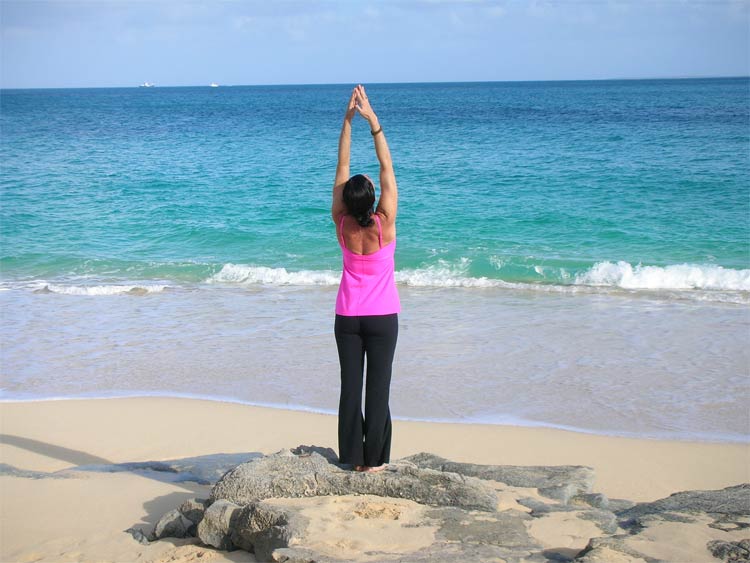My company, Bare Bones Yoga, is a reflection of my commitment to keeping yoga simple. The poses I offer may not be simple, per se, but I try to offer them in an accessible way with essential instruction.
When I attend classes as a student, I also try to bring with me a sense of “keeping it simple” as well, so as to minimize stress and maximize my experience. Here are 10 ways to keep your yoga practice simple:
1. Bring Only The Essential Items For Your Practice With You To Class
Make the action of going to yoga all about going to yoga. Leave your heavy bags, computers and personal items at home. If you have a mat, bring it but leave extraneous items at home. You’ll also have less to worry about when you leave it in the lobby.
2. Leave Your Cell Phone Outside The Practice Area
Think of yoga as a time to disconnect from the outside and connect to the inside. This starts with disconnecting from social media, email and the phone.
3. Leave Your Watch Outside The Practice Area
Let the teacher worry about what time it is and have faith that class will end on time. There’s something very freeing about not having to worry about time. Spend the time getting lost in the movements, your breath and the fluctuations of your mind.
4. Start Turning Inward As Soon As You Enter The Studio
Yoga studios have wonderful communities and part of the experience for you may include chatting with others before class. While this can be a heartwarming part of your pre-practice experience, think about being mindful as you enter.
Make your movements mindful, even as you move through the room to gather your props. Refrain from heavy walking, closing doors loudly and using a loud voice. Be respectful of people as you unroll your mat, as they may be starting to relax in the room and may be distracted by loud noises. Use the minutes before class to start to take a few deep breaths and bring your body into a more connected state.
5. Gather All The Props You Need At The Start Of Your Practice
Even if the teacher does not indicate what you’ll need for that particular practice, gather two blocks, a strap and a blanket. You’ll be prepared for whatever comes up, will have extra items in case you need them and won’t have to break the flow in order to gather more props.
6. Set Up A Neat, Clean Practice Area
Think of setting your practice area up as if you were to set the table for a special meal. Your blocks at the front of the mat, where you can reach them easily, your strap neatly rolled up on the side and a blanket on the other side, neatly folded.
Having a clean mat will allow your mind to rest, will allow you to quickly access what you need and demonstrates respect for other yogis, as you minimize the area you need for practice (versus having your items strewn all over).
7. Minimize Extra Movements As Much As Possible
One of the challenges of a yoga practice is to minimize extra movements, so each movement has purpose. This allows one to create a sense of flow and also maximizes your energy. This is harder to do as you’re newer but even for beginners, it can be a technique to introduce early on, to help one begin to settle into the meditative aspect of yoga.
8. Take Care Of Any Studio Business After Class Or Possibly, Remotely
Think of your practice time as a time away from stress, extended conversation and anything that could potentially detract from your time on the mat. This might include things that have to do with settling up your account at the front desk, taking time to do extra items besides checking in or asking questions about the status of your membership.
Think of what you can do to make the time from when you enter the studio to when you get on your mat the shortest possible distance so you can begin to relax.
9. Tap Into A Sense Of Compassion And Gratitude At The Start Of Your Practice
Regardless of the focus of your practice- whether it’s a set of challenging arm balances or the purity of restorative postures, take a moment to tap into a sense of gratitude, compassion or any other feeling that conjures up the idea of softening.
Remember that the attitude and mindset that you bring to your practice will color the whole thing. Even if you’re ready to work hard, starting from a soft place will allow you to be more mindful, efficient and effective in each pose.
10. Wear Or Bring Something Comforting To Use During Savasana
If you have a favorite hoodie, scarf or something to use to cover your eyes, bring it. Use the resting time at the end of your practice to be as fully restorative as possible.
Also, at the end of your practice, return your props neatly, so as to show respect for the next student that needs to use them.
Image credit: Karen Fabian


